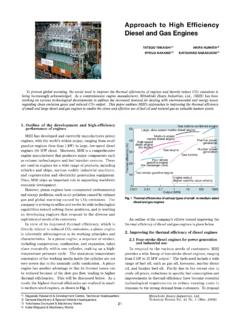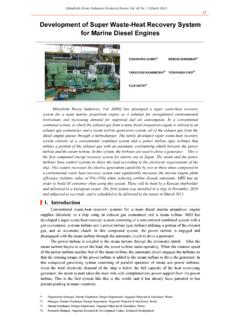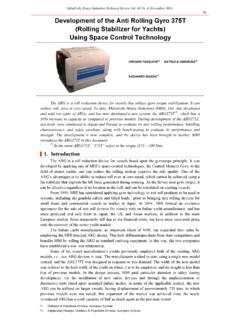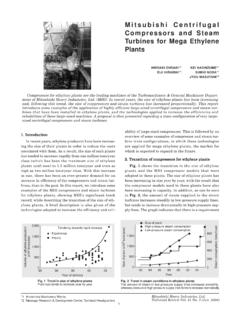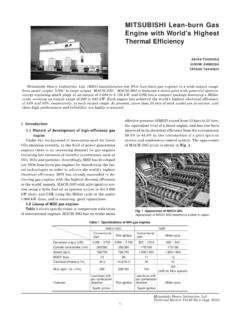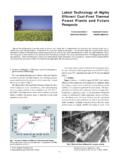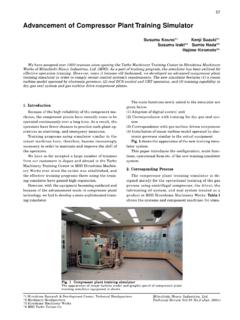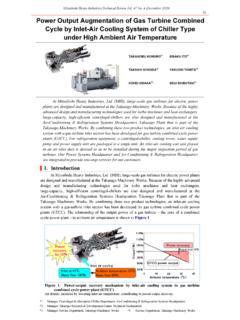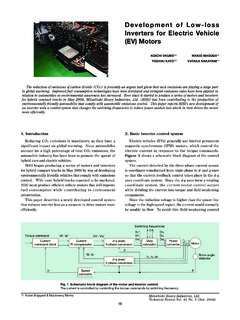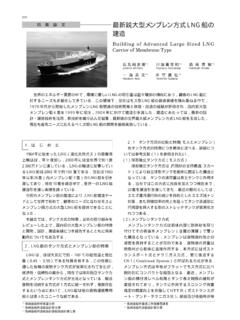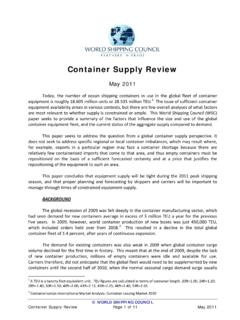Transcription of Development of Containerized Energy Storage System with ...
1 Mitsubishi Heavy Industries Technical review Vol. 50 No. 3 (September 2013) 36 *1 Electrical Department, Plant Engineering Division, Engineering Headquarters *2 Senior Manager, Power Systems Project Management Division, Engineering Headquarters *3 Lithium Battery Department, Power Systems *4 Electrical Department, Plant Engineering Division, Engineering Headquarters *5 Chief Staff Manager, Lithium Battery Department, Power Systems Development of Containerized Energy Storage System with Lithium-ion batteries NAOKI SONODA*1 HIROSHI MATSUNAGA*2 TADASHI GENGO*3 MASAAKI MINAMI*4 MASAZUMI OISHI*5 TSUTOMU HASHIMOTO*5 The lithium-ion battery has the characteristics of low internal resistance, as well as littlevoltage decrease or temperature increase in a high-current charge/discharge state.
2 The battery is expected to be used not only in a transportation uses such as electric vehicles (EV), but also forstationary Energy Storage such as in the stabilization of renewable Energy , the adjustment of powergrid frequency and power peak-shaving in factories. Mitsubishi Heavy Industries, Ltd. (MHI) has been developing a large-scale Energy Storage System (ESS) using 50Ah-class P140 lithium-ion batteries that we developed. This report will describe the Development status and applicationexamples. |1. Introduction The old status quo was that electric power could not be stored, and power should begenerated in accordance with need.
3 In other words, the electric company operated and kept thedemand/supply balance in the electric System , which momentarily fluctuated. Some Energy storagesystems such as pumped hydro Storage have existed, but, their large size of such facilities limitedpotential installation sites, and the Energy /utilization efficiency has been low. However, recentenergy Storage systems, especially the lithium-ion battery technology used in electric vehicles, have shown remarkable innovation. The wide feasibility of the battery allows any installation location,from a supplier s power plant to ordinary houses and factories.
4 In addition, a wide variety ofoutput, ranging from several kW to MW-class, as well as capacities (time endurance) ranging from several minutes to several hours, are easily realized. An electric Energy Storage System utilizing a battery can be charged during times of powersurplus or low prices, and discharged when power demand or prices are high. The technology ofthis electric Energy Storage System and its expansion using batteries can be a tipping point in thehistory of electricity, in the sense that electric power can be handled as a general consumer good.
5 As any retailer knows, buy low and sell high; and from the perspective of the consumer, stock upwhen commodities are cheap for later use. |2. Functions required in the electric Storage System Various applications of the Energy Storage System are planned. Many functions from the perspectives of power generation, transmission and distribution companies, consumers andrenewable Energy companies are shown in Table 1. Load leveling or peak shaving is known as time shifting, and Energy stored in during a power surplus can be used during peak consumption.
6 The power generating company has theMitsubishi Heavy Industries Technical review Vol. 50 No. 3 (September 2013) 37 advantages of the lower capability margin, cost reduction by substituting the electric Storage systemfor an adjusting thermal power generation and other benefits, while consumers have the advantages of lower electricity prices with the day time consumption of stored power generated at night, renewable Energy company has the advantage of the capability to sell electricity in a high-price time period. Table 1 Functions required in Energy Storage System (ESS) FunctionRequired capacity (hours)
7 Power generating company Time shifting2 to 8 hoursElectricity quality maintenance15 to 30 minutesPower distributing company Electricity quality maintenance15 to 60 minutesGrid congestion relief3 to 6 hoursExtension of facility life3 to 6 hoursConsumer Time shifting4 to 6 hoursEmergency power source5 minutes to 1 hourParallel operation with photovoltaic panels and EV3 to 5 hours Renewable Energy company Time shifting3 to 5 hoursOutput stabilization10 seconds to 15 minutes The electricity quality to maintain the grid frequency and voltage, which was handled bythe increase/decrease of generator output power, and the voltage change with a tap changer in transformer, is now attained by charging/discharging lithium-ion batteries utilizing ESS.
8 In addition, with the installation of ESS in an appropriate transformer station, a suddenincrease of demand can be responded to in a short time, and congestion relief and the extension of facility life can also be realized. Moreover, a more stable power supply will be available with the rapid charging/dischargingof ESS in rapidly fluctuating wind power and photovoltaic power generation through the installation of ESS by renewable Energy companies. This further contributes to the easing of theload on the grid, as well as a reduction in greenhouse effect gases such as carbon dioxide.
9 Theinstallation of ESS may also be a solution to grid connection problems through the capacity limitation of mega-solar power plants, which are rapidly increasing in number. |3. Development of Containerized Energy Storage System Our company has been developing a Containerized Energy Storage System by installing a varyingly utilizable Energy Storage System in a container from 2010. The module consists of eightof our lithium-ion battery cells and the Cell Monitoring Unit (CMU) as shown in Figure 1. The battery rack consists of the required number of modules, the Battery Management Unit (BMU), a breaker and other components.
10 The container consists of the required number of the battery racks,as well as air conditioning and fire extinguishing equipment. As for the Power ConditioningSystem (PCS), which is indispensable to the Energy Storage System , various structures of (a)installed in the same container with the battery racks, (b) installed in a PCS dedicated container ,and (c) installed outside the container are prepared in consideration of System size. Figure 1 ESS structure Mitsubishi Heavy Industries Technical review Vol. 50 No. 3 (September 2013) 38 The advantages of supplying the Energy Storage System in a container are as noted below: The dedicated air conditioning equipment controls the temperature in the container .
